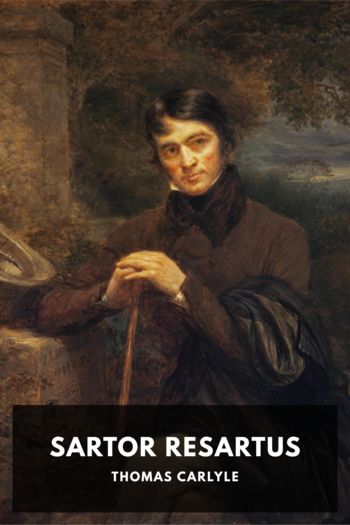Lavengro, George Borrow [i love reading books txt] 📗

- Author: George Borrow
Book online «Lavengro, George Borrow [i love reading books txt] 📗». Author George Borrow
Interview between William Taylor (21 King Street, Norwich) and George Borrow. —Knapp ↩
Orm Ungarswayne: “Orm the youthful Swain,” Romantic Ballads, p. 86. But see the Danish ballad “Birting” in Borrow’s Targum, St. Petersburgh, 1835, pp. 59–61, commencing:—
“It was late at evening tide,
Sinks the daystar in the wave,
When alone Orm Ungarswayne
Rode to seek his father’s grave.”
—Knapp ↩
Swayne Vonved: See this piece in Romantic Ballads, pp. 61–81. —Knapp ↩
Mousha, read “Muça,” in Arabic or “Moshé” in Hebrew; both represent our “Moses.” But the Jew’s name was Levi, according to the MS. —Knapp ↩
The Fight: Between Painter and Oliver, near North Walsham, 17th July, 1820. This chapter XXIV relates the author’s call on Mr. Petre of Westwick House, which must have been after 20th May, when it was decided that the “battle” should take place within twenty miles of Norwich. —Knapp ↩
Parr: There were two Parrs, one, Thomas, called “English” or “Old” Parr (1483–1635) who lived 152 years, and Samuel, called the “Greek” Parr (1747–1825,) who had been Head Master of the Norwich Grammar School from 1778 to 1785. This Dr. Samuel Parr was the one referred to by Mr. Petre. —Knapp ↩
Whiter: Rev. Walter Whiter, author of the Commentary on Shakespeare, London 1794, and Etymologicum Magnum, Cambridge, 1800. —Knapp ↩
Game Chicken: Henry Pierce, nicknamed Game Chicken, beat Gulley, 8th October, 1805 (Egan’s Boxiana, I, p. 145). —Knapp ↩
Sporting Gentlemen: John Thurtell and Edward Painter (“Ned Flatnose”). —Knapp ↩
Harmanbeck: Slang for “constable”—word taken from the English Rogue. —Knapp ↩
MS., “John Thurtell.” —Knapp ↩
Batuschca (read “Bátyooshca”) —Knapp ↩
Priberjensky, read “Préobrazhenski:” Crack regiment of the Russian Imperial Guard, so called from the barracks situated near the Church of the Transfiguration (Préobrazhenïe). —Knapp ↩
The Fight of 1820, chapter XXVI. We will here give a condensed portion of a chapter which we suppressed from the Life.
On the 20th of May, 1820, an eager crowd might have been seen pressing up to a card displayed in the Castle Tavern, Norwich. The card was signed “T. C.” and “T. Belcher;” but every one knew that the initials stood for the Champion of England, Thomas Cribb. The purport of the notice was that Edward Painter of Norwich was to fight Thomas Oliver of London for a purse of 100 guineas, on Monday, the 17th of July, in a field within twenty miles of the city.
A few days after this announcement, George Borrow was charged by his principals to convey a sum of money to a country gentleman by the name of John Berney Petre, Esq., J.P., residing at Westwick House, some thirteen and a half miles distant on the North Walsham road. The gentleman was just settling the transfer of his inheritance, his father having died eight months before. Borrow walked the entire distance, and while he tarried with the magistrate, the interview took place between him and Thurtell who desired to secure a field for the fight. Mr. Petre could not accommodate them, and they drove on to North Walsham. There they found the “pightle” which suited them in the vicinity of that town, on the road leading to Happisburgh (Hazebro).
Norwich began to fill on Saturday, the 15th of July, as the stagecoaches rolled in by the London (now Ipswich) and Newmarket roads. The Inn attached to the Bowling Green on Chapel-Field, then kept by the famous one-legged ex-coachman Dan Gurney, was the favourite resort of the “great men” of the day. Belcher, not old Belcher of 1791, but the “Teucer” Belcher, and Cribb, the champion of England, slept at the Castle Tavern, which like Janus had two faces—backed on the Meadows and fronted on White-Lion. The Norfolk in St. Giles and the Angel on the “Walk,” housed other varieties of the sporting world.
At an early hour on Monday, the 17th, the roads were alive with pedestrians, equestrians, Jews, Gentiles and Gypsies, in coaches, barouches and vehicles of every sort. From Norwich they streamed down Tombland into Magdalen street and road, out on the Coltishall highway, and thence—sixteen and one half miles in all—to North Walsham and the field. One ancient MacGowan (the Scotch for Petulengro) stood on Coltishall bridge and counted 2,050 carriages as they swept past. More than 25,000 men and thieves gathered in concentric circles about the stand.
I do not propose to attempt the description of this celebrated pugna or “battle with the fists.” Those who crave such diversions will find this one portrayed fittingly in the newspapers of the time. The closing passage of one of them has always seemed to me to be a masterpiece of grim brutality: “Oliver’s nob was exchequered, and he fell by heavy right-handed blows on his ears and temple. When on his second’s knee, his head dangled about like a poppy after a shower.”
A second fight, this time between Sampson, called the “Birmingham boy,” and Martin the “baker,” lost much of its interest by reason of the storm described in Lavengro. “During the contest,” says the Norfolk Chronicle, “a most tremendous black cloud informed the spectators that a rare sousing was in preparation for them.” And the Mercury states that “the heavy rain drenched the field, and most betook themselves to a retreat, but the rats were all drinkled.” Thus the “cloud” was no fiction, by which the Gypsy foretold the dreadful fate awaiting John Thurtell before Hertford gaol, 9th January, 1824. Ned Painter never fought again. He was landlord of the White Hart Inn from 1823 to 1835. The present proprietor still shows his portrait there, with the above fact





Comments (0)